
Brighton is a seaside resort and one of the two main areas of the city of Brighton and Hove in the county of East Sussex, England. It is located 47 miles (76 km) south of London. Archaeological evidence of settlement in the area dates back to the Bronze Age, Roman and Anglo-Saxon periods. The ancient settlement of "Brighthelmstone" was documented in the Domesday Book (1086). The town's importance grew in the Middle Ages as the Old Town developed, but it languished in the early modern period, affected by foreign attacks, storms, a suffering economy and a declining population. Brighton began to attract more visitors following improved road transport to London and becoming a boarding point for boats travelling to France. The town also developed in popularity as a health resort for sea bathing as a purported cure for illnesses.

Dame Flora McKenzie Robson was an English actress and star of the theatrical stage and cinema, particularly renowned for her performances in plays demanding dramatic and emotional intensity. Her range extended from queens to murderesses.

Leicester Square is a pedestrianised square in the West End of London, England. It was laid out in 1670 as Leicester Fields, which was named after the recently built Leicester House, itself named after Robert Sidney, 2nd Earl of Leicester. The square was originally a gentrified residential area, with tenants including Frederick, Prince of Wales and the artists William Hogarth and Joshua Reynolds. It became more down-market in the late 18th century as Leicester House was demolished and retail developments took place, becoming a centre for entertainment. Major theatres were built in the 19th century, which were converted to cinemas towards the middle of the next. Leicester Square is the location of nationally significant cinemas such as the Odeon Luxe Leicester Square and Empire, Leicester Square, which are often used for film premieres. The nearby Prince Charles Cinema is known for its screenings of cult films and marathon film runs. The square remains a tourist attraction which hosts events, including for the Chinese New Year.

Louis Aimé Augustin Le Prince was a French artist and the inventor of an early motion-picture camera, and director of Roundhay Garden Scene.

Wilmslow Road is a major road in Manchester, England, running from Parrs Wood northwards to Rusholme where it becomes the Oxford Road. The name of the road changes again to Oxford Street when it crosses the River Medlock before reaching Manchester city centre.

The Elgin & Winter Garden Theatres are a pair of stacked theatres in Toronto, Ontario, Canada. The Winter Garden Theatre is seven storeys above the Elgin Theatre. They are the last surviving Edwardian stacked theatres in the world.

New Brighton railway station serves the suburb of New Brighton in Wallasey, Merseyside, England. It is situated at the end of the New Brighton branch of the Wirral Line 8.25 miles (13.28 km) west of Liverpool Lime Street on the Merseyrail network.
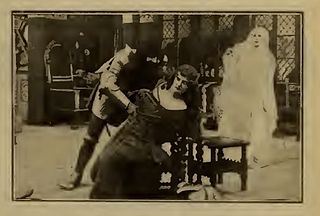
Das Mirakel is a black-and white silent German film made and released in 1912, directed by Mime Misu for the Berlin film production company Continental-Kunstfilm GmbH. It was based on Karl Vollmoeller's 1911 play, The Miracle. The film was originally advertised as The Miracle in Britain and the US, but after copyright litigation in both countries it was shown as Sister Beatrix and Sister Beatrice respectively. In Germany it was known as Das Marienwunder: eine alte Legende.

The Regent Theatre is a theatre in Stoke-on-Trent, England. Constructed in 1929 as a cinema, it is one of several theatres in the city centre and one of two operated by the Ambassador Theatre Group on behalf of Stoke-on-Trent City Council. The building was converted for full-time use as a theatre in 1999, and since then has hosted a number of shows and musicals. The theatre is also the northern base for the Glyndebourne Touring Opera.

The Saville Theatre building is a former West End theatre and cinema at 135 Shaftesbury Avenue in the London Borough of Camden. The theatre opened in 1931, and became a music venue during the 1960s. In 1970, it became a cinema, most recently as the Odeon Covent Garden.
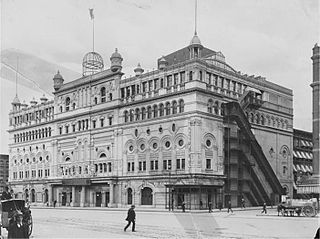
The Olympia Theatre, also known as Hammerstein's Olympia and later the Lyric Theatre and the New York Theatre, was a theater complex built by impresario Oscar Hammerstein I at Longacre Square in Manhattan, New York City, opening in 1895.

Brighton and Hove City Centre is the commercial and cultural centre of the city of Brighton and Hove. Geographically, the so-called city centre is located in an easterly part of the Brighton and Hove urban conurbation.
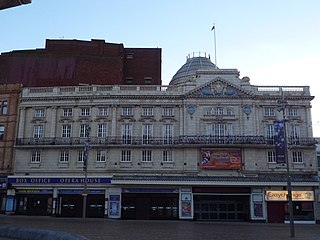
The Opera House Theatre is a theatre in Blackpool, Lancashire, England. It is located within the Winter Gardens, a large entertainment complex in the town centre and originally opened in 1889, although it has been rebuilt twice, in 1910 and 1939.
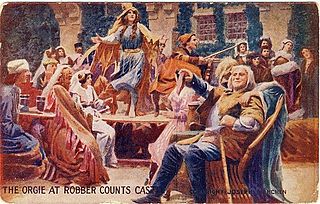
The Miracle (1912), is a British silent full-colour film, using a hand-coloured process similar to Pathéchrome. Produced by Joseph Menchen and directed by Michel Carré, it is among the first full-colour feature films to be made. It stars Maria Carmi, Ernst Matray, Florence Winston and Douglas Payne, and was filmed on location in Austria.
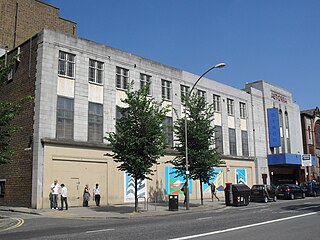
The Astoria Theatre was a former cinema in Brighton, part of the English coastal city of Brighton and Hove. Built in 1933 in the Art Deco style for a local entertainment magnate who opened one of Brighton's first cinemas many years earlier, it was the first and most important expansion of the Astoria brand outside London. It initially struggled against the town's other "super-cinemas", but enjoyed a period of success in the 1950s and 1960s before rapid decline set in, culminating in its closure in 1977.

Miss Mabel is a 1948 stage play by R. C. Sherriff. It has been adapted for television at least five times. The original production premiered at the Theatre Royal, Brighton before transferring to London's West End where it ran for 180 performances between 23 November 1948 and 30 April 1949, initially at the Duchess Theatre before switching to the Strand Theatre. The West End cast included Richard Warner, Clive Morton and Mary Jerrold.
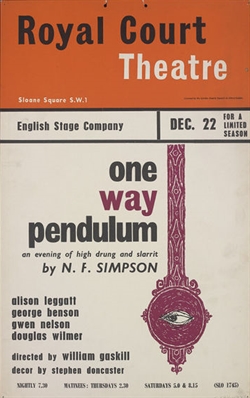
One Way Pendulum, described on the title page as "A Farce in a New Dimension", is a play by N. F. Simpson. It was first performed at the Theatre Royal, Brighton on 14 December 1959, before playing at London's Royal Court Theatre from 22 December, later transferring to the Criterion Theatre where it ran until 11 June 1960. The play was adapted for the cinema in 1965.
The Terror is a 1927 mystery thriller play by the British writer Edgar Wallace. It is based on Wallace's 1926 novel The Black Abbot.
Araminta Arrives is a 1921 play by the British writer Dorothy Brandon. It is a historical romantic comedy, set in the nineteenth century, about a young woman going to live with her aunt in London and becoming involved in a series of entanglements with men.
Number 17 is a 1925 thriller play by the British writer Joseph Jefferson Farjeon.

















